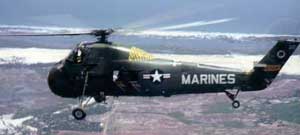| Welcome To Al's Vietnam Home Page
Poems
& Letters A Pictorial Account of
|
U.S. Marines In Vietnam
While every effort has been made to maintain complete, updated and accurate information, this site is not an official source for information about the Vietnam War or the United States Marine Corps. I hope the
material I supplied below will be helpful to all high school and college students learning
about the history of the Vietnam War.
Material found on this page
was supplied from the book titled
"Charlie of the South"
"Another Landing"
|
|
|
||
"A Plot To Defend"
" Things That Kill"
Hot, tired, smelly and uncomfortable, you hear a voice. "Cold soda, Marine?" You smile a "yes!" She flips
off the soda top and pours the fluid into a paper cup full of chipped ice. You gulp down a
large mouthful of the cold, sweet fluid. Small chips of ice slide down your throat along
with the soda. Then you realize, too late, that slivers of glass are cutting your stomach
. . . from the inside, out. The games people play in Vietnam are deadly. One loaf of bread contained a hand grenade. Cpl Burley Boykin was point man on a patrol with Co., 3d Recon Bn., when he tripped a homemade Viet Cong booby trap. The jazzed up I, beer can was filled with bits and pieces of discarded metal and Boykin caught 80 of them throughout his body. Boykin was
lucky. Though a painful encounter, he would live and walk the point again. But he walked
ever so cautiously!
Punji stakes, sharp needles of bamboo, are concealed along paths and roads. Advancing Marines come under enemy fire and dive for concealment . . . to be pierced by deadly points which have been dipped in animal excreta to infect those not receiving fatal punctures. Viet Cong booby traps don't look good. They aren't smooth, shiny or professional in make-up or composition. They're crude, clumsy, unbalanced, often resembling Rube Goldberg inventions. Some are primitive, such as huge, heavy balls of mud which contain pointed spears. They're hung high and fall heavily on unsuspecting troops below. Some are ridiculous. You'd laugh, until the thing exploded, knocking the grin off your face. Then you'd realize, they're things that kill!. Enemy booby traps came in a varity of shapes and sizes. Some crude; others, highly sophisticated. Marine explosive experts, engineers, recon SCUBA teams and scout dogs continually searched for the gadgets of death. Some Marines chose to ignore the dangers of hidden explosives. It often proved a costly mistake. Some lived...many did not.
"Chasing' Charlie"
But it wasn't the helicopter or the steel monster which found, faced and fought the enemy. It was the grunt. It was the young Marine, the recent enlistee who was trained, supplied, armed and transferred to Vietnam, who made the final contact with Charlie. It was the grunt who made Charlie run.
"The Sky Is Ours"
On the ground
in Vietnam, the enemy may be anywhere, but in the air, it's a different kind of The air belongs to allied jet jockeys, transport humpers and chopper poppas. Marine aircraft, regardless of size, shape or speed, drone unopposed through the skies of South Vietnam. Marine close air support is like a poker hand with three jets as openers. Skyhawks, Phantoms and Intruders provide surprise, punch, speed and countless enemy casualties. The Intruder, an all-weather attack bomber, can carry 28 500-pound bombs, flying through any natural weather disturbance which grounds other aircraft. Supersonic Phantoms with bombs, rockets and the 20mm mini gun (which "burps" 4000 rounds a minute, or 65-70 rounds per second) provide headache number 44 to enemy guerrillas moving towards friendly lines. Skyhawks, stubby-winged jets, have recorded 120 sorties a day, dropping more than 10,000 tons of ordnance, up to 1000 pounders. But it isn't all jets in the 'Nam. Jumbo, cargo planes, as the C-130 Hercules, burdened with men, mail, chow and whatever else there's room for, waddle out to the flight line, grunt and groan, then lumber into the air like gooney birds. Observation craft, the O-1E Bird Dogs, unarmed and slow moving, carried six 2.75mm Willy Peter rockets for marking targets for the jets. Helicopters come in a variety of shapes and sizes. First, there was the thinly clad, mosquito-like Sea Horse. It was small and could carry a limited load, but it was a workhorse, and dependable. They ferried wounded from battle. They carried beans, bullets and broads. The latter, visiting USO troops. They flew plasma, VIPs, rockets or water. The Sea Knight was huge in comparison, and could carry a lot more weight. It also mounted .50 caliber machine, guns instead of the .30's the Sea Horses toted. A Huey is a polliwog-like machine with a bump for a nose and a sawed off cigar for an exhaust, but no one laughs as it "whomp whomps" across the sky. It carries a rocket pod on each side, mounting eighteen 2.75-inch rockets. Two mounted machine guns are situated atop the rocket pods. From the Huey evolved the Cobra, smaller, thinner, but with one hell of a sting! It boasts a rapid firing mini-gun pod that spits either 3000 7.62 rounds, or, with a flick of a switch, belches out a total of 279 40mm grenades. Alongside the Cobra's center are rocket pods that carry 56 high explosive rockets. Another innovation, introduced in Vietnam, is the OV-10A "Bronco," similar in design to the Lockheed Lightning or Black Widow of World War II. The plane is armed with four internal 7.62 machine guns, two on each side. It can carry a total load of 3600 pounds of bombs, or marking rockets, Sidewinder missiles or the fast-firing mini-guns. During the monsoon season, with torrential rains blanketing the airstrips, the enemy figured they'd have it knocked. No aircraft, they reasoned, could take off under such conditions.
The enemy may roam the paddy or jungle, but sometimes he forgets, the sky is ours!
Many hard core Viet Cong and North Vietnamese soldiers surrendered to allied forces because of the continued pounding, strafing or hazing by Marine pilots and their aircraft. Without Marine pilots and their "birds," the story of Hill 881 or the results of the stand at Khe Sanh might have had a much different ending.
"The Gentle Side"
A Marine rode, shotgun on a resupply convoy. Clutched in one hand, a loaded M-16; in the other, a bag filled with candy. As the convoy bounced its way along the pockmarked highway, curious children were met with handfuls of wrapped sweets.
The Third Marine Division's Memorial Children's Hospital at Quang Tri or the, Hoa Khanh Children's Hospital at FLC are more like Stateside hospitals than most in Vietnam. Marines, Navy men and Seabees built them and have continued supporting them with money, materials and a sympathetic love. Never before had Marines been asked to rebuild a country as they secured it, During the Pacific island campaigns of World War 11, Marines fixed bayonets, charged, scored a victory and moved on to another island, leaving the mopping up to, other allied units. In Vietnam, during an 18-month period, nearly two million South Vietnamese received free medical and dental care offered through a variety of medical civic action programs, or MedCaps.
Marines, grunts, wing wipers and supply men constructed dispensaries, showers, wells, latrines, playgrounds, walkways, schools, markets, roads, dikes, culverts, school furnishings, fences, bridges -even pig sties.
A brick factory operated by the 7th Marine Engineers obtained raw material from CARE and employed refugee labor to make bricks which were then supplied, without cost, to hamlets in the area for schools. The work of Marines in their fight toward Vietnarnization wasn't fully shouldered by those in Vietnam alone. In the States, Marine reservists, commercial companies and individual families contributed huge amounts of items needed by the Vietnamese. One pharmaceutical company in California's Bay Area contributed more than a million dollars worth of medical supplies! The Vietnamese didn't get supplies by merely asking for them. It wasn't a large "hand out" program. They got materials because they needed them, as determined by a Marine representative and the village chiefs. Among projects designed specifically to, increase the level of education was the General Walt Scholarship Program, established in 1967 to assist needy students showing potential as future leaders. The program grew from 465 elementary and high school scholarships to over a thousand! Financial support was provided by the Marine Corps Reserve Civic Action Fund. Today's Marine stands ready as "first to fight . . but there's another side of him. Hundreds of former Viet vets are contributing monthly to clothe, feed and educate countless orphans. The kids might be Catholic, Protestant or Buddhist most is the fact they're kids. Faces of combat Marines are hard, crusted with sweat and lined with concern. Removed from the fields of battle and placed in a surrounding of kids, the Marine's face softens, and the crust of grime cracks to reveal a grin. The Marine will replace his rifle with the small hand of a child, and though neither understands a word of the other, they share a common warmth.
"Nguyen Of The North..."
It marked a turning point in the war. The enemy proved to be members of the 95th Regiment, 325th Alpha Division, North Vietnamese Army.
At that time, it was estimated that seven NVA regiments had crossed into South Vietnam; an eighth was considered "probable" and a ninth, "possible." By early 1968, four NVA divisions and elements of two other divisions were fighting in the south. ' How does Nguyen of the North differ from his fighting ally, Charlie of the South? Nguyen is a "bo doi" or basic infantryman. He'll wear a simple, lightweight uniform which may be many colors, including gray, gray-green, khaki or even robin egg blue. He wears a light, camouflage covered pith helmet.
He's comfortably dressed and well armed, carrying a modern, effective ChiCom copy of a Russian weapon, either an SKS carbine, AK-47 assault rifle, light machine gun or rocket launcher. The SKS, AK and machine gun use the standard 7.62 cartridge. Operating in the field, he's formed into squads, platoons, companies, battalions, regiments and divisions. He utilizes the "triangular" concept with three squads per platoon, three platoons per company and so forth. (A squad is 10 men divided into three cells.) A rifle company has from 60 to 130 men and includes three rifle platoons and a weapons platoon which has 60mm mortars, 57mm recoilless rifles and light machine guns. A regiment (1400 to 2000 men) may have special units attached, as signal, engineer, recon or medical, and may carry heavy machine guns, 120mm mortars and 70mm or 75mm pack howitzers. Communications units carry field telephones, small hand radio sets or sophisticated switchboards and transmitters. Engaged, they frequently use the "close embrace" tactic, meaning they get as near as possible to the enemy (as they did to Marines at Khe Sanh) to prevent the use of supporting fire. The NVA is not a rinky-dink outfit. Nguyen has proved himself a well-trained, professional combatant. During "Operation Hastings" in July 1966, Task Force Delta with 2/1, 2/4 and 3/4, the Special Landing Force (3/5), 1/1 and 1/3 clashed with NVA of the 324B Division. In all, 8000 Marines and 3000 South Vietnamese troops met Nguyen and his comrades. Then began "Operation Prairie" and "Deckhouse IV." Nguyen of the North was fighting with his back against his homeland. He was well equipped; well trained; well supplied. But he was not invincible. Before the end of January 1967, nearly 1400 NVA had been killed during operations around the DMZ. The NVA had moved concentrations of troops into the South through the DMZ because it was an easier route than along the Ho Chi Minh jungle trail. Also, moving through the Demilitarized Zone shortened Nguyen's supply lines. He was stopped by American Marines . . . but it wasn't a permanent halt. He'd be back . . . at Mutter's Ridge, Khe Sanh, Hill 881 and Meade River. Marines would hear more of Nguyen of the North.
Special Thanks to
Thanks for stopping by
|
||


 Generally, early combat operations were similar in design. Marine helicopters landed
grunts on the outskirts of villages and hamlets and the Marines established a perimeter.
Vietnamese interpreters instructed the villagers to form in a group and move to a
centralized location. Once the villagers (generally only women and children) had moved to
comparative safety, Marine fire teams rushed into the village to search for the enemy.
They were almost always met by VC snipers. The enemy was a pathetic looking lot . . .
small, slim, barefoot and poorly armed, but he was determined, and he could and very often
did, kill. Charlie of the South was elusive, cunning and tireless. He thought of himself
as a patriot and often opened fire, single handedly, on advancing Marine companies or even
battalions! He fought in small units, and often died . . . all alone, deserted by other
members of his cadre.
Generally, early combat operations were similar in design. Marine helicopters landed
grunts on the outskirts of villages and hamlets and the Marines established a perimeter.
Vietnamese interpreters instructed the villagers to form in a group and move to a
centralized location. Once the villagers (generally only women and children) had moved to
comparative safety, Marine fire teams rushed into the village to search for the enemy.
They were almost always met by VC snipers. The enemy was a pathetic looking lot . . .
small, slim, barefoot and poorly armed, but he was determined, and he could and very often
did, kill. Charlie of the South was elusive, cunning and tireless. He thought of himself
as a patriot and often opened fire, single handedly, on advancing Marine companies or even
battalions! He fought in small units, and often died . . . all alone, deserted by other
members of his cadre.
 History has a strange
way of repeating itself. In May 1845, American Marines went ashore from the USS
Constitution in an attempt to release a French Catholic missionary from prison.
History has a strange
way of repeating itself. In May 1845, American Marines went ashore from the USS
Constitution in an attempt to release a French Catholic missionary from prison.
 They were like
homesteaders. They came ashore, were assigned plots, and they dug in.
They were like
homesteaders. They came ashore, were assigned plots, and they dug in.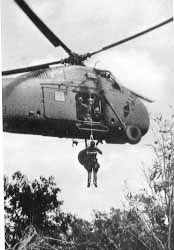
 Your back is sticky with sweat and the jacketclings and chills. An
odor flows upward, out of the open neck of your utility shirt, and you discover with a
grimace that the smell is you.
Your back is sticky with sweat and the jacketclings and chills. An
odor flows upward, out of the open neck of your utility shirt, and you discover with a
grimace that the smell is you. The Viet
Cong's ability to make weapons from discarded objects is uncanny. Their tools are crude.
Few enemy guerrillas have any technical knowledge explosives. They're lackadaisical in
their approach to providing pain.
The Viet
Cong's ability to make weapons from discarded objects is uncanny. Their tools are crude.
Few enemy guerrillas have any technical knowledge explosives. They're lackadaisical in
their approach to providing pain.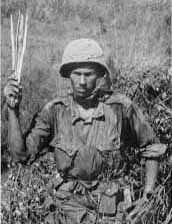

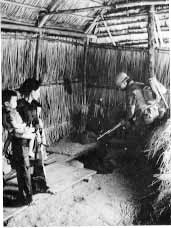
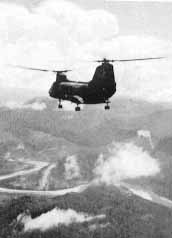 war.
war.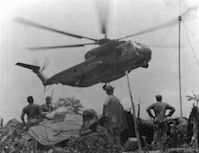 Then came
the Sea Stallion, an assault transport cargo helicopter, largest in the Free World's
arsenal. Built especially for Marines, it carried 38 combatladen troops. Dubbed
"Super Bird," it can trail a 20,000-pound external load. Top speed: 170 knots.
Then came
the Sea Stallion, an assault transport cargo helicopter, largest in the Free World's
arsenal. Built especially for Marines, it carried 38 combatladen troops. Dubbed
"Super Bird," it can trail a 20,000-pound external load. Top speed: 170 knots.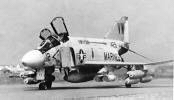 The role played by
Marine aviators and the importance of Marine aircraft in Vietnam may never be properly
told. In addition to aerial observation and reconnaissance, close air support, saturation
bombing, strafing runs, medical evacuations and delivering the mail, aircraft provided a
great morale boost to ground units while seriously demoralizing the enemy.
The role played by
Marine aviators and the importance of Marine aircraft in Vietnam may never be properly
told. In addition to aerial observation and reconnaissance, close air support, saturation
bombing, strafing runs, medical evacuations and delivering the mail, aircraft provided a
great morale boost to ground units while seriously demoralizing the enemy. 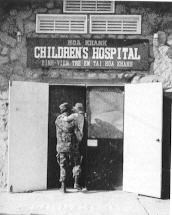 Marines writing
home about the many orphans were rewarded with boxes of clothing, soap and food. Not
only were cartons received during December,
but folks back home provided a
year 'round Christmas.
Marines writing
home about the many orphans were rewarded with boxes of clothing, soap and food. Not
only were cartons received during December,
but folks back home provided a
year 'round Christmas.
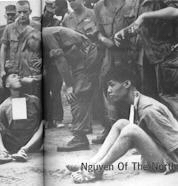 Just
before Thanksgiving Day, 1965, 3/7 met an enemy force near Quang Ngai. Three of the enemy
were killed. Eight weapons were captured.
Just
before Thanksgiving Day, 1965, 3/7 met an enemy force near Quang Ngai. Three of the enemy
were killed. Eight weapons were captured.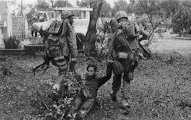 He
carries plastic canteens on a thin webbed belt, and if he carries a knife, it'll be crude;
homemade. He'll have an entrenching tool, and wear the canvas, rubber soled shoes, or
"Ho Chi Minh" rubber sandals.
He
carries plastic canteens on a thin webbed belt, and if he carries a knife, it'll be crude;
homemade. He'll have an entrenching tool, and wear the canvas, rubber soled shoes, or
"Ho Chi Minh" rubber sandals.
